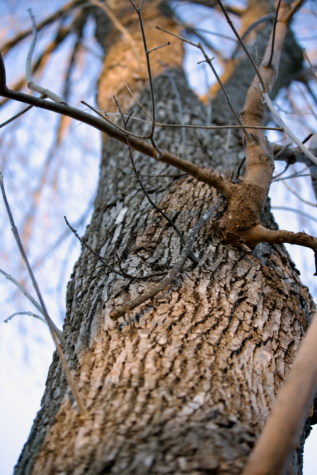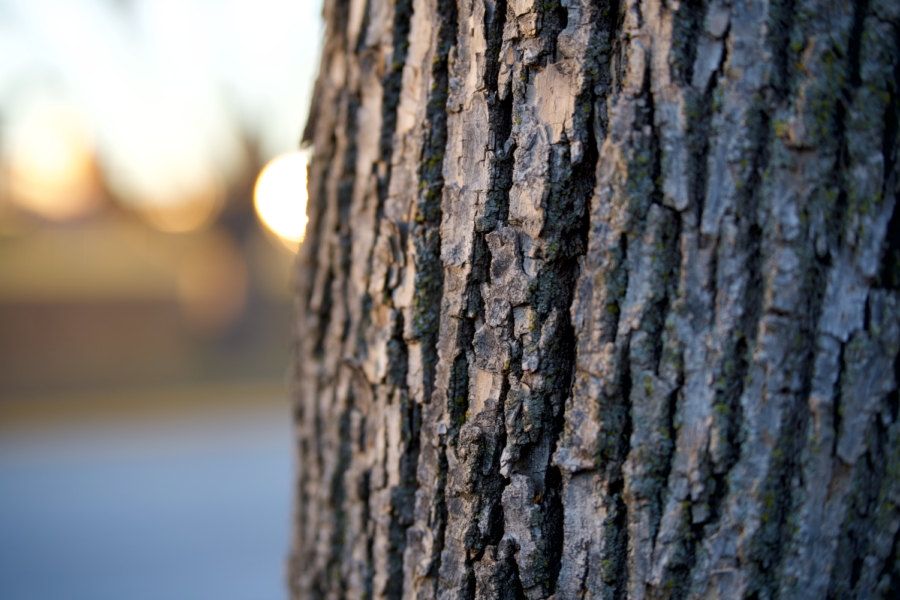Invasive species threatens ash trees in Ames
An ash tree on Ash Ave. Nov. 30, 2022.
Editor’s note: The images previously featured in this article were silver maple trees, not ash trees. The article has been updated with the proper images. The Daily regrets this error.
Ash Avenue, a street in Ames south of Iowa State’s campus, was named for the ash tree which can be found around the city. However, for a street with such a name, you might see fewer ash trees than you’d expect.
Collin Fett, a resident of Ash Avenue, has a large ash tree in his front yard. It’s been there since he and his family moved to Ash Avenue in 2018, but Collin says it will probably be cut down in the next couple of years.
“It’ll suck because it’s nice to have that tree, it’s gonna cost a lot of money,” Collin said. “It provides shade, and I like the look of the neighborhood with the big 70-year-old trees.”
Collin’s tree is dying, but the problem goes beyond Ash Avenue. Ash trees across North America are dying due to the emerald ash borer.
The emerald ash borer is an invasive species of insect. Its first recording in North America was in Michigan in 2002. It was first found in Iowa in 2010. The insect has been found in 84 of Iowa’s 99 counties and has affected 3.5 million acres of land, according to the Iowa DNR’s 2021 Forest Health report.
The insect infects ash trees by laying its eggs underneath the bark. The larvae eat the tree’s cambium, a tissue necessary for transporting water throughout the tree, which then causes the tree to die slowly. The process takes about two years.
As they consume the tissue, the emerald ash borers leave a series of squiggly tunnels called galleries underneath the bark. Other signs of infestation include bark deformities, D-shaped exit holes and dieback, when a tree begins to die from the tips of its leaves, moving toward the roots.
In Iowa, there are an estimated 50 million ash trees in forested areas and 3 million in urban areas. Brandon Pitts, the owner of Pitts Lawn and Tree Service, said his business removes trees for the city of Ames. He estimated that over the last two years, he has removed around 800 ash trees.
“Within the last year, actually, I’ve seen a lot of people call for [EAB],” Pitts said. “I think it took a while for people to notice that their trees were infected.”
Miranda Curzon, an associate professor in the Natural Resource Ecology and Management Department at Iowa State University, said that the infestation is causing problems for cities like Ames.
“There’s a large potential for impact,” she said. “A lot of cities are scrambling to figure out whether they need to remove the ash trees now preemptively.”
Curzon said that affected ash trees have a mortality rate of around 99%. While there is no cure, preemptive measures can be taken.
“If you wanted to keep a tree, you would treat it before it is showing any signs of EAB,” Curzon said.
Preemptive treatment for an ash tree involves an injection of insecticide into the tree every two years. Curzon said several ash trees on Iowa State’s campus are being treated, and she is treating one in her own yard.
“It’s 90 years old, it’s huge!” Curzon said. “It provides shade, and I’m just not ready to let it go.”
Curzon said this is only a short-term solution while she begins growing other trees. She said the treatment is expensive. Landowners have to decide how important their tree is to them and balance the cost of removal with the cost of treatment.
Collin said he has not considered treating his tree because it would cost him $200 every two years, and cutting it down seemed like the right option.
Once a tree passes the point of treatment and is further along in the dieback process, it becomes a safety hazard. At this point, the tree needs to be removed.

Pitts said the cost of removing a tree varies greatly based on the size of the tree, how close it is to the house and how accessible it is. He said an average cost would be around $1,500 to $1,800.
Despite the high mortality rate and the large spread of the problem, Curzon said there are efforts to maintain the populations of the emerald ash borer. A parasitic wasp has been released in multiple states, including Iowa, that is a natural enemy of the emerald ash borer. The wasp is not harmful to humans but will hopefully be effective at reducing the impact of the invasive species.
“It’s been pretty devastating,” Curzon said, ‘but everyone hopes that there’s resistance, so that’s one argument against preemptively cutting all the ash.”
The effects of losing so many ash trees go beyond the loss of shade and the cost of removal. The loss of the species would be harmful to the species diversity of North America’s wetland forests, which have already lost elm trees.
Curzon said that while this is not as big of a problem in Iowa, it will have a big impact on Minnesota and Michigan.
“It makes ecosystems more vulnerable,” Curzon said. “When EAB comes in and eliminates [the ash trees] it’s very unlikely that there’s going to be natural tree regeneration. That has implications for water control and some communities are worried about flooding.”
Additionally, ash trees hold traditional value. For many Native American tribes, the ash tree is of great importance.
For the Wabanaki people of the northeastern United States, the black ash, in particular, is a big part of their tradition. In their story of creation, the black ash became the source of life for the Wabanaki people when it was struck with an arrow by a mythic hero.
Curzon said that while ash trees may not completely disappear, they will be much more sparse and will play a different role in the environment. She compared the ash tree to the American chestnut tree.
Chestnut was also affected by a disease that left very few standing today. However, some younger chestnuts still exist as part of the understory of forests rather than the canopy.
“For ash, I could see that happening,” Curzon said.”Rather than ash being completely eliminated, it may just function differently for a time.”
If you have an ash tree that you think may be infested with the emerald ash borer, contact the Iowa DNR’s Forest Health Program Leader, Tivon Feeley, at 515-725-8453 or the IDALS EAB Coordinator, Mike Kintner, at 515-725-2877.
Your donation will support the student journalists of the Iowa State Daily. Your contribution will allow us to purchase equipment, send our student journalists to conferences and off-set their cost of living so they can continue to do best-in-the-nation work at the Iowa State Daily.















Diane | Dec 2, 2022 at 9:01 am
Great informative story.
Sherry Hoyer | Nov 30, 2022 at 9:09 am
Thank you for reminding the public about both Emerald ash borer and the importance of preparing for the impact of the infestation. One note about the prevalence: The “Iowa Tree Pests” website (associated with Iowa Department of Agriculture and Land Stewardship) shows that as of Sept. 20 this year, EAB has been confirmed in 94 counties.